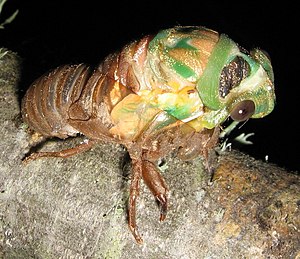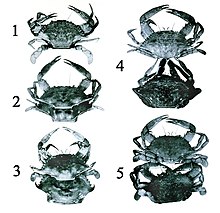Molting animals
| Molting animals | ||||||||||||
|---|---|---|---|---|---|---|---|---|---|---|---|---|

A molting cicada |
||||||||||||
| Systematics | ||||||||||||
|
||||||||||||
| Scientific name | ||||||||||||
| Ecdysozoa | ||||||||||||
| Aguinaldo et al., 1997 |
The molting animals (Ecdysozoa) are an overstem of the primal mouths (Protostomia), by Anna Marie A. Aguinaldo u. a. Proposed in 1997 primarily on the basis of the sequence analysis of 18S rRNA . The name is composed of the Greek words ecdysis ( moulting ) and zoon ( animal ).
The molting animals include the following animal phyla:
-
Panarthropoda
- Arthropod (arthropoda)
- Tardigrade (Tardigrada)
- Colibus (Onychophora)
- Lobopods (Lobopodia) †
-
Cycloneuralia
- Roundworms (Nematoda)
- String worms (Nematomorpha)
- Hookweed (Kinorhyncha)
- Priapulida (Priapulida)
- Corset animal (Loricifera)
Ecdysozoa versus Articulata
The Ecdysozoa concept contradicts the older Articulata concept.
In the Articulata concept, the Panarthropoda are grouped together with the annelid worms , while according to the new system, the annelid worms are not counted among the molting animals , but among the Lophotrochozoa (Lophotrochozoa).
In addition to the sequencing data on rRNA (and other nucleic acids ), there are also some common morphological features that suggest a kinship group of molting animals.
Other characteristics common to many molting animals:
- internal fertilization in many species
- Absence of cilia used for movement
- separate sexes (females and males), although some groups are parthenogenetic and the males may have lost in the course of evolution .
While various molecular genetic test methods confirm the molting animals as a community of descent, the morphological characteristics listed above are usually not considered convincing. On the morphological level, the traditional Articulata concept has more advantages, because here the origin of the arthropod blueprint can be convincingly explained from a ringworm-like ancestor, while the Ecdysozoa concept offers no explanations in this regard.
More recent studies, which do not examine DNA sequences as a whole, but try to find patterns in rare, larger regroupings of the genome, could not confirm the Ecdysozoa hypothesis and even offer arguments for the original Articulata hypothesis. So the question is scientifically controversial to this day.
Suggested solutions
As a compromise solution to the problem, it has been proposed to adopt a sister group relationship between annelids and molting animals. This would confirm the Ecdysozoa concept, but it would still be possible to derive the segmented organization of the arthropod from a ringworm-like ancestor. With this solution, however, it would have to be accepted that not only the arthropods, but probably also all the remaining molting animals are descended from ringworm-like precursors: Many of these, however, show no trace of any external segmentation. In addition, molting animals with a pseudocoel (especially the Cycloneuralia) would probably have to be traced back to an ancestor with a secondary body cavity ( coelom ). In terms of molecular biology, this “Annelida + Ecdysozoa” solution proposal is unconfirmed, but also difficult to test because, contrary to traditional opinion, the Annelida are probably not a monophylum . Even if the search for an Ecdysozoa sister taxon can be restricted to the ringworm group of polychaeta , there are still up to 24 orders with more than 80 families to be checked.

In other explanations, the segmented construction plan of the arthropod would have to have arisen completely independently of the segmented annelid worms. As a result, attempts are made to connect the molting animals to presumed predecessors via other characteristics. The occurrence of a three-sided symmetrical muscular suction pharynx in tardigrade (whose blueprint largely corresponds to that of the arthropod) and nematodes was emphasized here . Based on this supposedly primeval trait of the molting animals, a possible sister group was searched for.
In this regard, they found what they were looking for in the abdominal corset (Gastrotricha), as these also have a three-sided symmetrical suction pharynx. However, it has not been possible to support such a special position of the belly curls in molecular biology. The similar shape of the suction pharynx is also not a convincing feature, since it can be explained functionally, i.e. it could be a convergence instead of a homology . For this reason, special cuticle features of the abdominal curls were recently pointed out in order to be able to hold onto the hypothesis of a close relationship to the molting animals for the time being.
Since the belly parsnips are unsegmented, the question of the origin of the segmented arthropods (and, associated with them, the colobus and tardigrade) remains unanswered.
literature
- Anna Marie A. Aguinaldo, James M. Turbeville, Lawrence S. Linford, Maria C. Rivera, James R. Garey, Rudolf A. Raff, James A. Lake: Evidence for a clade of nematodes, arthropods and other moulting animals. In: Nature. 387, 1997, pp. 489-493, doi : 10.1038 / 387489a0 .
- Claus Nielsen: Proposing a solution to the Articulata-Ecdysozoa controversy. In: Zoologica Scripta. 32, No. 5, 2003, pp. 475-482, doi : 10.1046 / j.1463-6409.2003.00122.x .
- Andreas Schmidt-Rhaesa, Thomas Bartolomaeus, Christian Lemburg, Ulrich Ehlers, James R. Garey: The position of the Arthropoda in the phylogenetic system. In: Journal of Morphology. 238, No. 3, 1998, pp. 263-285, doi : 10.1002 / (SICI) 1097-4687 (199812) 238: 3 <263 :: AID-JMOR1> 3.0.CO; 2-L .
Web links
- Introduction to the Ecdysozoa on ucmp.berkeley.edu (English)
Individual evidence
- ↑ Anna Marie A. Aguinaldo et al. a .: Evidence for a clade of nematodes, arthropods and other moulting animals. In: Nature . 387, 1997, pp. 489-493 ( doi : 10.1038 / 387489a0 ).
- ↑ IB Rogozin, YI Wolf, L. Carmel, EV Koonin (2007): Ecdysozoan clade rejected by genome-wide analysis of rare amino acid replacements. Molecular Biology and Evolution 24: 1080-1090. doi : 10.1093 / molbev / msm029 .
- ↑ JE Blair, K. Ikeo, T. Gojobori, SB Hedges (2002): The evolutionary position of nematodes. BMC Evolutionary Biology 2: 7. doi : 10.1186 / 1471-2148-2-7 .
- ↑ Partho Sarothi Ray & Paul L. Fox (2014): Origin and Evolution of Glutamyl-prolyl tRNA Synthetase WHEP Domains Reveal evolutionary Relationships within Holozoa. PLoS ONE 9 (6): e98493. doi : 10.1371 / journal.pone.0098493 .
- ↑ Claus Nielsen: Proposing a solution to the Articulata-ecdysozoan controversy. In: Zoologica Scripta. 32, No. 5, 2003, pp. 475-482 ( doi : 10.1046 / j.1463-6409.2003.00122.x ).
- ↑ Andreas Schmidt-Rhaesa u. a .: The position of the Arthropoda in the phylogenetic system. In: Journal of Morphology . 238, No. 3, 1998, pp. 263-285 ( doi : 10.1002 / (SICI) 1097-4687 (199812) 238: 3 <263 :: AID-JMOR1> 3.0.CO; 2-L ).